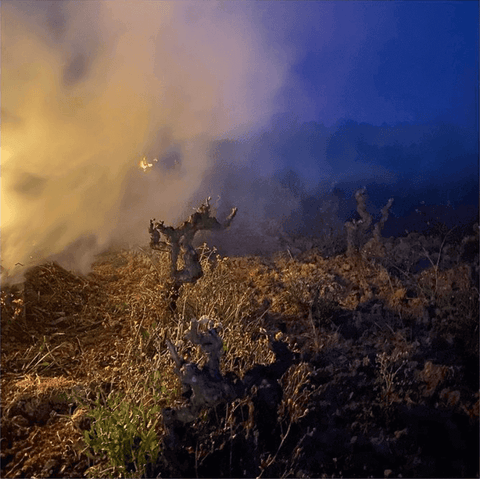“April is the cruelest month…” – T.S. Eliot, The Wasteland
Those of us fortunate enough to have gardens, look forward to spring – while cautiously containing the urge to get planting and pruning mindful of the ever-present danger of a late frost.
For many French winemakers this year brought a 3-day spell of snow, frost and plummeting temperatures of epic proportions over the 6th, 7th and 8th of April. Hot on the heels of an unusually warm March, some vines were already at the point of bud-break and at their most vulnerable to damage. When you have warm March days with temperatures around 20 degrees that’s more than enough to encourage the vine’s sap to flow and bud break to begin.
This was no ordinary “White Frost” – which just hits certain pockets of vines and which can be mitigated by the use of “bougies” amongst the vines. Rather it was a “Black Frost” – an air frost against which there is no possible remedy or protection.

Vineyards in Chablis – the temperature hit -7 degrees here. © Titouan Rimbault
Growers in Jura and Burgundy have suffered the worst damage, as Chardonnay starts its growing season early in these more southerly regions. Champagne, Bordeaux, the Rhône and the Languedoc have all suffered too. Jura in particular has seen a near wipe out.
The scale of losses (estimated at 2 billion euros) within viticulture and horticulture is such that the French Government has declared a state of emergency allowing them to release funding to support growers.

© Thibaud Clerget
In Champagne, 50% of the crop has been lost across the Aube region (home to many of the smaller growers whose Champagnes we love so much in The Good Wine Shop). The majority is Chardonnay (80%) but with both Pinot Noir (50%) and Pinot Meunier (30%) severely affected too.
Champagne’s routine use of Reserve Wines in non-vintage blends allows it the latitude to swallow a truly bad year – there’s no such buffer for the other affected regions.
Some growers in the Northern Rhône vineyards have lost as much as 90% of potential crop and even Châteauneuf-du-Pape in the far south has been affected. In Bordeaux the damage is far more sporadic, depending on where vineyards lie and which varieties were planted. Merlot in particular starts its growing season early so is most at risk of spring frost while Cabernet Franc and Cabernet Sauvignon have been less affected.
Further afield Piemonte and Tuscany have especially hard hit by the same Black Frost this year.
Down in the west of the Languedoc, temperatures hit -4 degrees early in morning – and that was at the top of slopes. Frost always settles in the lowest pockets – it was -6 degrees in the lower lying vineyards, and being further south growth was ahead.

Old vines at Domaine Jones in the Roussillon © Domaine Jones
Katie Jones has had more than her fair share of vine heartache. Her vines are all in small parcels spread over a 20 km area. Some are badly affected by this April’s frost, others less so.
Of course, frosts are not a new phenomenon in France – the notorious frost of 1956 decimated much of the South West, wiping out all the Malbec in the Cahors region as well as much of the Merlot and all the Malbec in Bordeaux’s vineyards. For that reason very little Malbec was replanted in Bordeaux.
More recently, 2017 saw a similar air frost in late April which affected many of our UK vineyards and much of the north of Europe very badly.
What can we do about it?
What makes it so hard to manage is the increasingly warm springs we’re seeing due to climate change meaning the vines are already at a tender point while late cold spells are still likely.
One possible change being suggested in Burgundy is to delay the start of pruning later in the year -effectively delaying the start of the vines’ growth cycle in the hope of avoiding the unfortunate collision of growth and frost.
What about insurance?
Very little agricultural land in France is insured against extreme weather. Punitive premium levels and poor levels of payout make it a non-starter for most growers. In Burgundy in particular, the situation is a Catch 22 – because insurers will only pay compensation based on the previous 5 years’ average production (which – of course, has been very low because of frost and drought) any compensation is reduced and while premiums remain high it’s simply cheaper to dice with nature each year.
One other longer-term possibility is re-considering the planting of higher slopes in regions where that’s possible. Climate change does mean areas once regarded as not suitable are becoming more viable. But, in most European winegrowing regions that will entail a decade plus of working through the proposed changes to existing regulation to get approval for new appellations or extension to existing ones – remember Chablis is only Chablis if it comes from within the Chablis Appellation. All of Western Europe (effectively the world’s three biggest wine producers – Italy, France and Spain) work with this model of regulation.

We could consider changing the grape varieties we use for later ripening ones – but that again would entail changing the regulations – and Chablis wouldn’t be Chablis either if it were made from Riesling.
“For the next six months I will have to look out of my office window at a vineyard we will have to maintain and nurture for the next six months knowing there are no grapes at the end of it.”
Tom Ford, Domaine Gayda Languedoc
(60 -70% losses at the Gayda Estate on their Chenin Blanc and Cabernet Franc)
For now let’s continue to enjoy these wines and support the winemakers as much as we can afford to and admire their perseverance in the face of nature’s worst.



